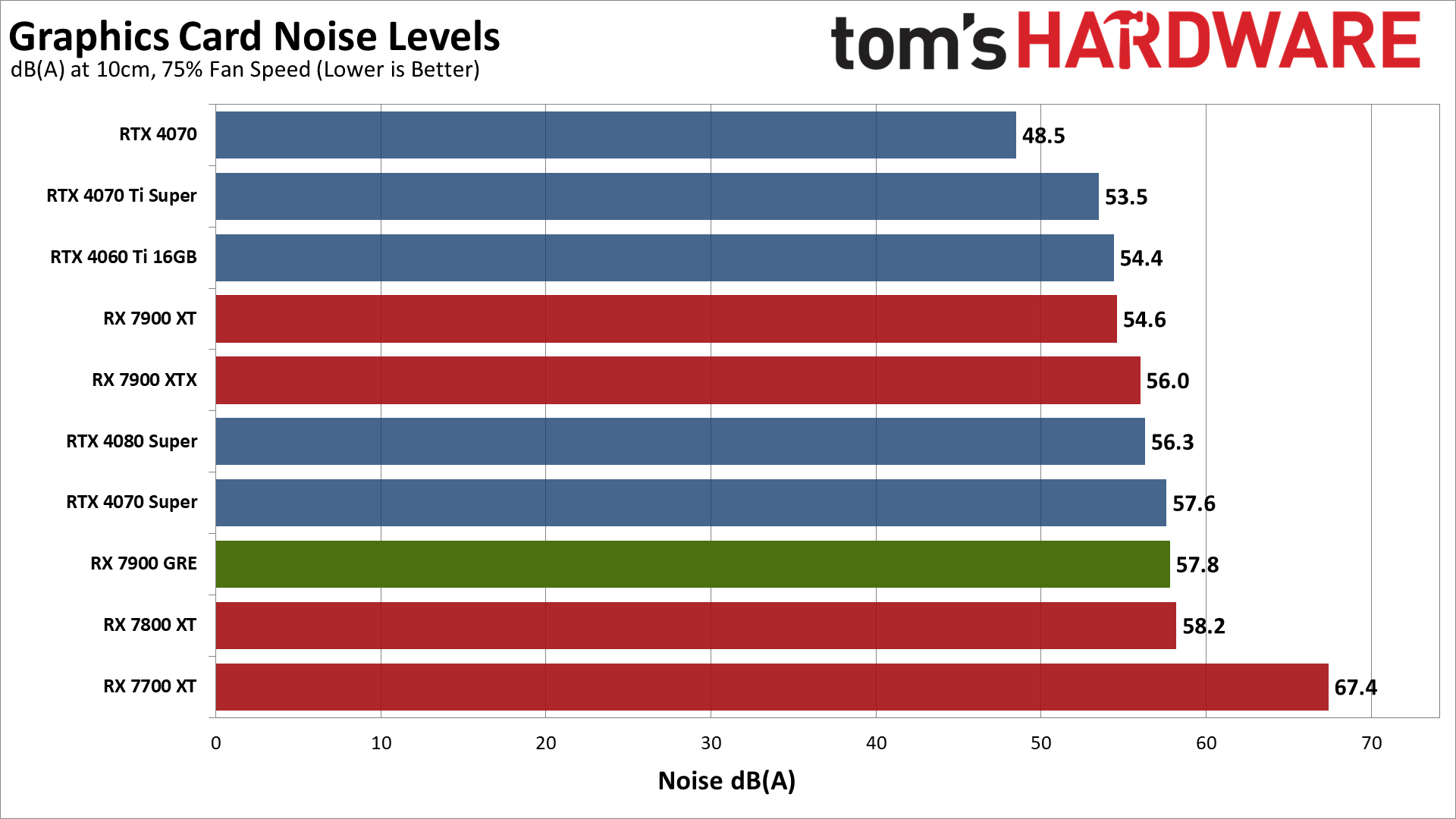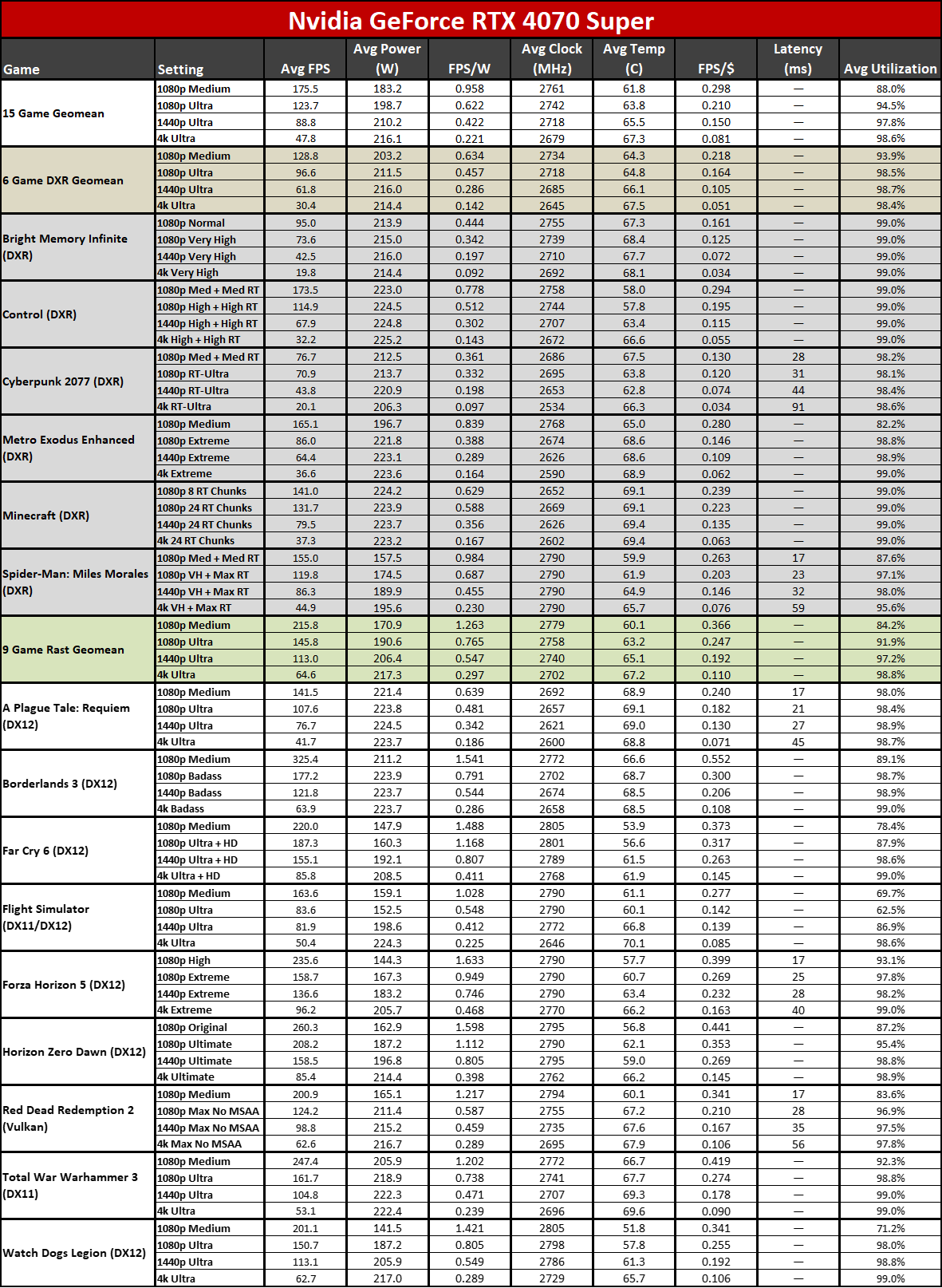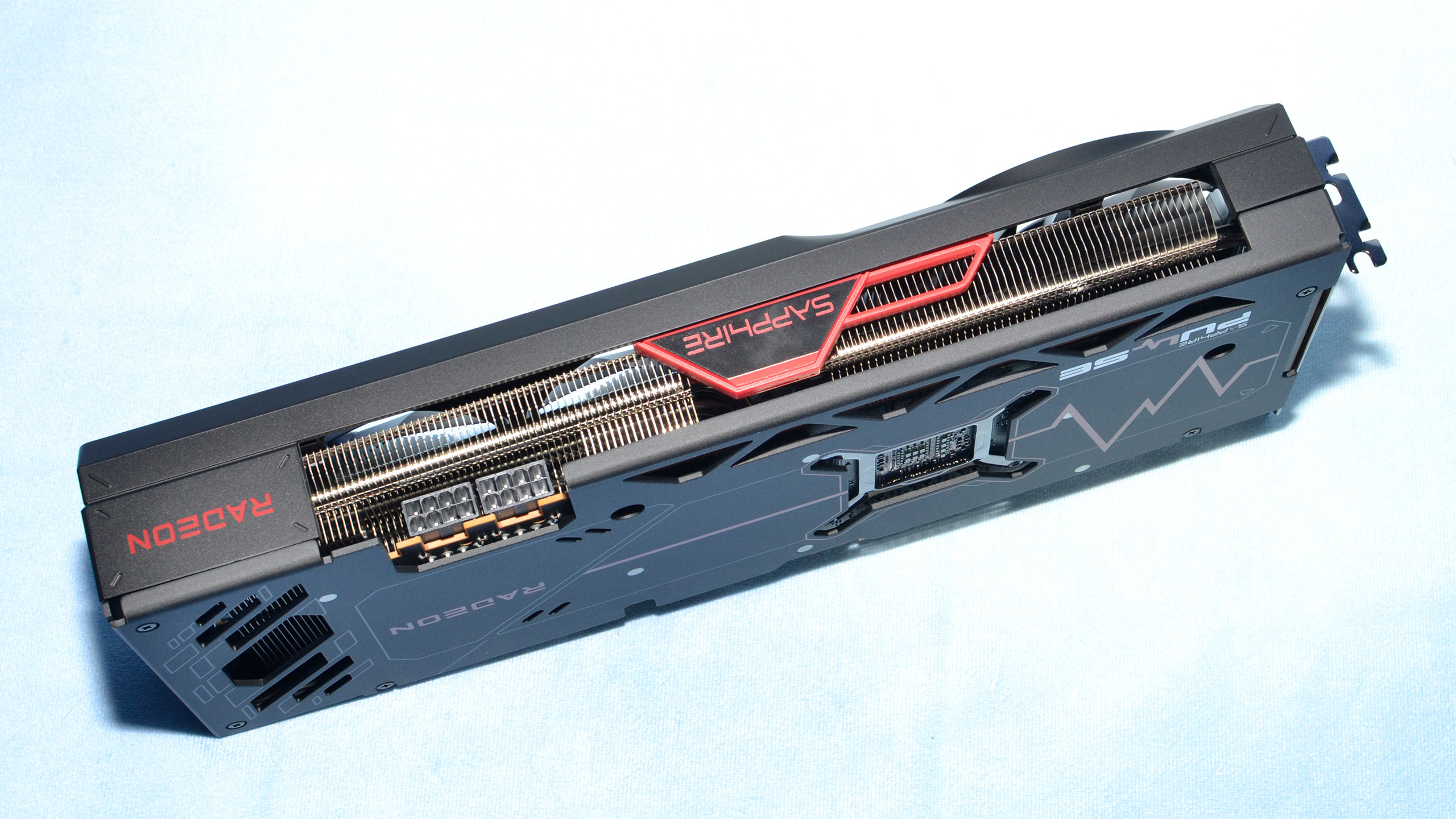Why you can trust Tom's Hardware
Our graphics card test PC uses an Nvidia PCAT v2 device, as it gives us far more data without the need to run separate tests. PCAT with FrameView allows us to capture power, temperature, and GPU clocks from our full gaming suite — along with the usual frame times. The charts below are the geometric mean across all 15 games, and we also have full tables showing the individual results further down the page.
PCAT does not favor Nvidia GPUs in any measurable way. We checked power with our previous setup for the same workload and compared that with the PCAT, and any differences were well within the margin of error (less than 1%). PCAT is external hardware that simply monitors the power draw of the PCIe power cables as well as the PCIe x16 slot by sitting between the PSU/motherboard and the graphics card.
We have separate charts for 1080p medium/ultra, 1440p ultra, and 4K ultra in the galleries below. There's no reference design for the RX 7900 GRE, and the Sapphire Pulse does appear to come with a factory overclock. It's a bit difficult to say exactly how far it's overclocked, though, because we can only see the maximum boost clock of 2460 MHz, while AMD's specs page lists an 1880 MHz "Game clock" and a 2245 MHz "Boost clock" — and the latter mostly dovetails with our in-game measurements, but quite a few games can exceed that clock.
AMD RX 7900 GRE Power Use




Officially, the RX 7900 GRE has a 260W TBP (Total Board Power) rating, but we don't know if Sapphire adheres to that or bumps things slightly. All of the games we tested, at all four resolutions, averaged less than 270W of power use, often substantially less at 1080p. Across all 15 games in our test suite, the 7900 GRE averaged 232W at 1080p medium, 250W at 1080p ultra, 255W at 1440p ultra, and 263W at 4K ultra.
That's decent overall, and represents some of the best results we've seen from RDNA 3 in terms of efficiency — the 7900 XT and XTX are only slightly better in our 4K tests. However, the 7900 GRE and AMD in general remain far behind Nvidia's competing GPUs. The overall similarly performing RTX 4070 for example has up to 50% higher FPS/W at 1080p, 35% higher at 1440p, and 25% higher at 4K.
The good news is that the 7900 GRE typically beats the 7800 XT in performance, while only using slightly more power. Still, officially the TBP for the 7800 XT is 263W and the 7900 GRE is 260W, but in practice the GRE almost always has slightly higher power use.
AMD RX 7900 GRE Clock Speeds




While AMD used its largest Navi 31 GCD for the 7900 GRE, with a lot more compute units than even a fully enabled Navi 32 GCD, it also specified substantially lower clocks. There could be a lot of overclocking headroom if you lift the power limit (we ran out of time and haven't done detailed overclocking tests yet), but the net result is that the 7900 GRE is the lowest clocked desktop GPU of the modern era that we've tested.
Average clocks across our test suite do match or exceed AMD's official boost clock, and it only ends up trailing the (reference) 7800 XT by 65~115 MHz, depending on the setting and resolution. With a higher power limit and some overclocking, though, it ought to be able to get relatively close to the 7900 XT clocks.
We do have another 7900 GRE for testing that has a higher factory overclock, so it will be interesting to see how that does in a future review.
AMD RX 7900 GRE Temperatures




GPU temperatures and fan speeds go hand in hand, and most modern GPUs are perfectly fine at up to 90C, give or take. Sapphire's 7900 GRE Pulse appears to aim for 75C or less, often staying below 70C, but in raw terms that makes it one of the hotter cards that we've tested.
We test in a 21C ambient, +/-2C, and the triple 95mm "Angular Velocity" fans should be more than enough to keep the GPU frosty. So, given the temperatures, let's see what noise levels and fan speeds look like.
AMD RX 7900 GRE Noise Levels


Here's where the Sapphire RX 7900 GRE earns an extra half star from our overall score. It's exceptionally quiet, considering the level of performance it offers, easily besting all of the other cards in this roundup. Of course the Nvidia cards are mostly Founders Edition reference designs — the Gigabyte 4060 Ti 16GB and Asus 4070 Ti Super being the exceptions. Even those two custom cards can't beat Sapphire.
We measured a noise level of just under 36 dB(A) at 10cm while running a demanding game. To put that into context, our newer test PCs are louder than that even when sitting idle. Our noise testbed is an older Core i9-9900K with an NZXT Kraken Z73 cooler just because it doesn't make much noise. The fan speed during our testing was only 25%.
We also test with fan speed set to a static 75%, which is more about seeing how much headroom there is for additional cooling if needed. The Sapphire card naturally created a lot more noise, hitting 58 dB(A), but we suspect the only way you'd ever get the card to reach that noise level would be with manually adjustments like we used.
Our noise test consists of running Metro Exodus, because it's one of the more power hungry games. We load a save, with graphics set to appropriately strenuous levels (4K ultra in this case), and then let the game sit for at least 15 minutes before checking noise levels.
We place the SPL (sound pressure level) meter 10cm from the card, with the mic aimed at the center of the middle fan. This helps minimize the impact of other noise sources, like the fans on the CPU cooler. The noise floor of our test environment and equipment is around 31~32 dB(A).
Full Gaming Test Results










For those who like to look at the finer details, we've provided the above tables showing all of our gaming benchmarks, which include FPS/$ and FPS/W metrics. We use the best prices we can find at the time of writing, and MSRP for newly launched cards like the RX 7900 GRE. In this case, the 4080 Super is the only card that starts at more than its $999 MSRP, with many cards costing substantially more — $1,300+ isn't uncommon.
More expensive cards generally have worse values, as measured by FPS/$. Of course, the cost of the rest of the system should also be considered if you're not just upgrading your graphics card. The RTX 4070 and 4070 Super end up being the top values out of the ten tested cards, with AMD's top value being the RX 7700 XT, though the 7800 XT and 7900 GRE aren't far behind.
The efficiency crown meanwhile isn't even close. The RTX 4080 Super and RTX 4070 Super take the pole position, depending on what resolution you look at, with the other RTX 40-series GPUs not too far behind. AMD's RX 7900 GRE ends up as its most efficient GPU that we've tested, but Nvidia's competing 4070 and 4070 Super are 25–50 percent more efficient.
- MORE: Best Graphics Cards
- MORE: GPU Benchmarks and Hierarchy
- MORE: All Graphics Content
Get Tom's Hardware's best news and in-depth reviews, straight to your inbox.
Current page: AMD RX 7900 GRE: Power, Clocks, Temps, and Noise
Prev Page AMD RX 7900 GRE: Professional Content Creation and AI Performance Next Page AMD RX 7900 GRE: A welcome addition to AMD's lineup
Jarred Walton is a senior editor at Tom's Hardware focusing on everything GPU. He has been working as a tech journalist since 2004, writing for AnandTech, Maximum PC, and PC Gamer. From the first S3 Virge '3D decelerators' to today's GPUs, Jarred keeps up with all the latest graphics trends and is the one to ask about game performance.
-
Notton So it falls directly between a 7800XT and 7900XT, and should have been called the 7900.Reply
It looks really good as a 1440p card.
It's not that interesting, considering it's price tag.
I'll wait to see what the RTX 5000 and RX 8000 series brings to the table, unless my 1070Ti croaks first. -
Giroro I'm surprised they didn't completely rebrand the card for the west. More generally, I'm surprised they're releasing it in the west at all.Reply
10% more performance for 10% more money isn't exciting, it's pointless. If they feel the need to release a minor stop-gap card, then I think they won't be ready to release anything truly exciting anytime soon. Maybe the AI surge has made them go back to the drawing board with RDNA 4.
It's hard to explain, but In my mind, something about calling it "Golden Rabbit" severely devalues it. So I imagine they at least will never spell out that acronym. Gold isn't valuable or aspirational; it's always cheap, fake, and tacky.
Also, I don't associate rabbits with being fast - I associate them with the weak fluffy bunnies that keep tearing up my yard.
Calling it golden means its a knockoff. It makes me think the GPU is actually some ancient Radeon HD 7970 chip that somebody is fraudulently trying to pass off as a counterfeit RX 7900 on Temu for $80 - or that it might have a virus or set my computer on fire.
Maybe I just buy too much counterfeit garbage from overseas. -
UnforcedERROR The conversation at $550 right now is almost specifically 1440p raster, which the 7900 GRE performs handily in. At these prices, 16 GB vs 12 GB for the 4070 is the biggest argument in its favor. Neither card is competent in Ray Tracing at 1440p, and the price-to-performance difference isn't enough to argue much otherwise, so it's mostly about longevity.Reply
As others said, it's not terribly interesting, and it feels like a notably late arrival, but it's something I suppose. I still feel like the $500 - $700 segment of cards is wholly disappointing from both NVidia and AMD. -
ohio_buckeye So it’s basically similar performance to a 6900xt or a 6950xt it sounds like? I’m happy with my 6800xt for now that I got under $450 new. I’ll hold onto that a while.Reply -
AgentBirdnest Hmm... I don't find it particularly exciting, but I don't have anything to complain about either. AMD had to do something to counter Nvidia's 4070 Super (and non-Super price drop), and this does it.Reply
What I'm really excited about, is where the 7800XT goes from here. I don't imagine it's going to stay at $500. If it drops to $450, that would be an extremely compelling option, and probably the best value of this generation.
As always, props to Jarred for the fabulous review! : ) -
thestryker Seems like decent enough perf/$, but doesn't really bring anything new to the table as expected. Not needing a video card has been a great place to be this generation as we're just now seeing some decent values though still limited to >$400.Reply
Per TPU the VRAM is limited to 2316mhz which caps the potential memory bandwidth at ~593 GB/s. The power limits on the card are at least standard so if anyone wants to try their hand at getting higher boost clock it is possible. -
ingtar33 this is basically just going to fill in the hole the 6900xt left in the market when it's stock ran out, they are both priced about the same, both perform about the same.Reply
It's not bad. the performance difference from the 7800xt to the 7900xt was pretty big (as was the $$ difference), this will slide right in between them at the old 6900xt price. It's a solid buy i think. I mean as solid as today's prices get.
everything is still overpriced. -
JarredWaltonGPU Reply
I do wish AMD hadn't lowered the VRAM speed from 20 Gbps. That probably would have given it another ~5% in performance, which would have been good. Right now, it's between the 7800 XT and 7900 XT, but slightly closer to the former. It makes sense from a pricing perspective, but even a few percent more overall performance would have been nice.ingtar33 said:this is basically just going to fill in the hole the 6900xt left in the market when it's stock ran out, they are both priced about the same, both perform about the same.
It's not bad. the performance difference from the 7800xt to the 7900xt was pretty big (as was the $$ difference), this will slide right in between them at the old 6900xt price. It's a solid buy i think. I mean as solid as today's prices get.
everything is still overpriced. -
Alvar "Miles" Udell Like all AMD cards for the last couple of generations, it's good, but it's just priced way too close to nVidia to be a true competitor, and this is no exception. At 2560x1440 and 3840x2160 the 4070 Super was effectively equal in terms of rasterization and superior with ray tracing, and it's only as little as $50 more expensive. How is AMD going to persuade all of the lifelong nVidia users and people like me who have had multiple negative experiences with Radeon cards to jump from Team Green over $50?Reply
And once third party custom models are included that price will exceed the 4070 Super, making the 7900 GRE a non starter. -
ohio_buckeye Reply
The good time to buy will be sales maybe around Black Friday imo. Now granted my 6800xt was last generation when I bought it this past December. On the other hand, $439 was a deal for a card that is essentially equivalent to a 7800xt.Alvar Miles Udell said:Like all AMD cards for the last couple of generations, it's good, but it's just priced way too close to nVidia to be a true competitor, and this is no exception. At 2560x1440 and 3840x2160 the 4070 Super was effectively equal in terms of rasterization and superior with ray tracing, and it's only as little as $50 more expensive. How is AMD going to persuade all of the lifelong nVidia users and people like me who have had multiple negative experiences with Radeon cards to jump from Team Green over $50?
And once third party custom models are included that price will exceed the 4070 Super, making the 7900 GRE a non starter.
As someone above said if they’d put the 7800xt at $450, or even $475 then it goes on sale, that would be a decent price to performance imo.

